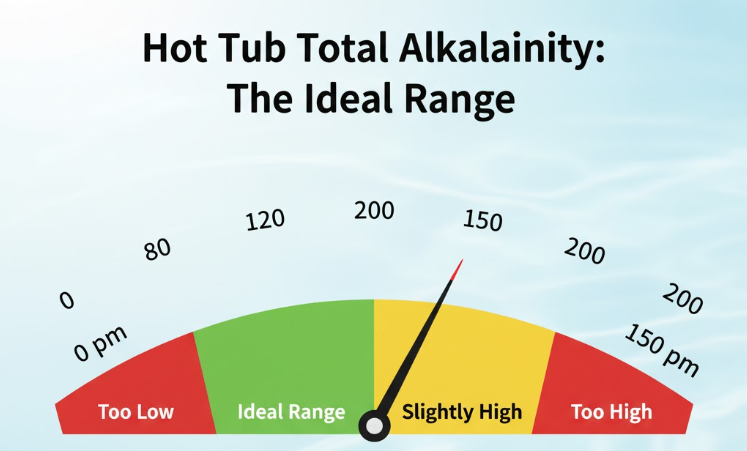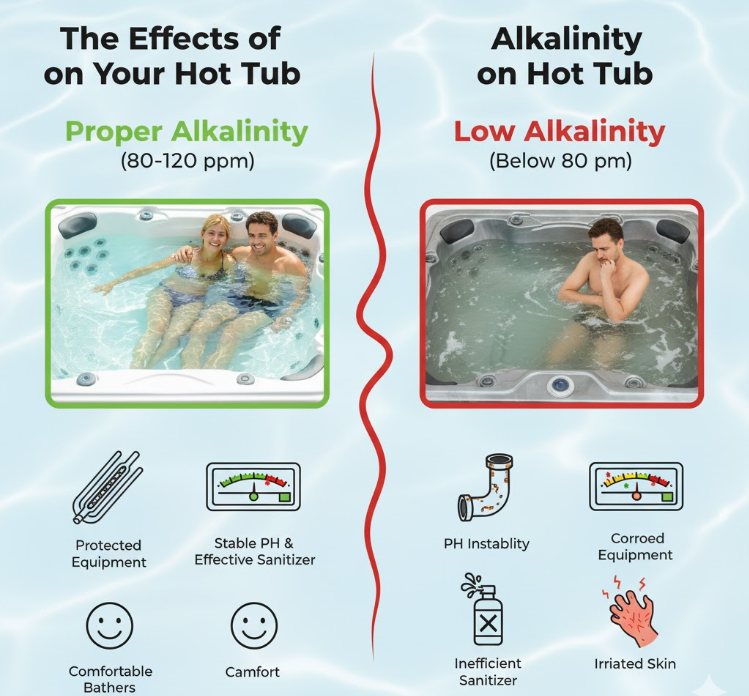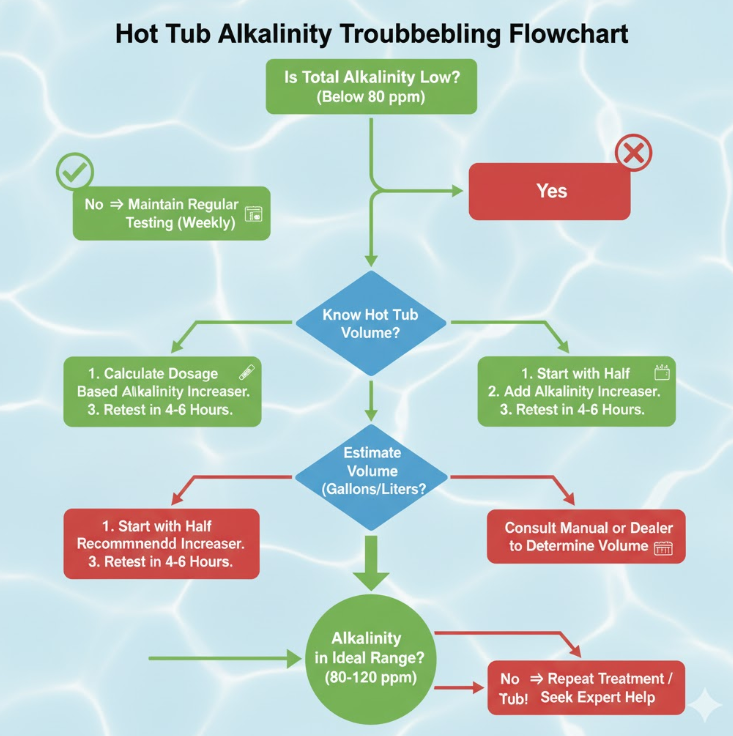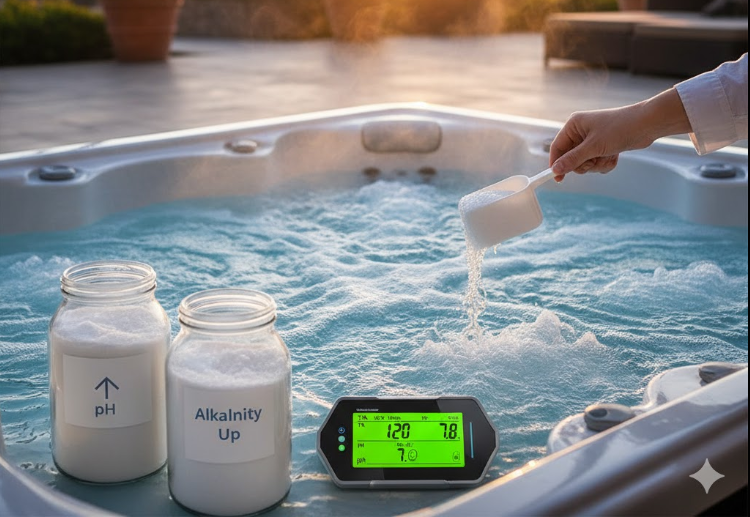Table of Contents - How to Raise Alkalinity in a Hot Tub: The Definitive Guide
- Understanding Total Alkalinity: Your Hot Tub’s pH Guardian
- Dangers of Low Alkalinity: What Happens When It Drops
- How to Test Your Hot Tub’s Alkalinity Level
- Step-by-Step Guide: How to Raise Alkalinity in Your Hot Tub
- Advanced Troubleshooting: When Alkalinity Won’t Stay Up
- Proactive Maintenance: How to Keep Your Alkalinity Stable
- Safety First: Handling Hot Tub Chemicals
- The Relationship Between Alkalinity and Other Water Parameters
- Common Mistakes When Raising Alkalinity
- When to Seek Professional Help
- Seasonal Considerations for Alkalinity Management
- The Economics of Alkalinity Management
- Understanding Water Chemistry Testing Accuracy
- Advanced Balancing: The Relationship Between Alkalinity and Chlorine Effectiveness
- Conclusion: Mastering Alkalinity for the Perfect Soak
- Frequently Asked Questions About Raising Hot Tub Alkalinity
- Can I use baking soda to raise alkalinity in my hot tub?
- What is the fastest way to raise alkalinity in a hot tub?
- Will raising alkalinity also raise my pH?
- Should I adjust pH or alkalinity first?
- How long after adding alkalinity increaser can I use my hot tub?
- Why does my hot tub alkalinity keep dropping?
- How much baking soda do I need to raise alkalinity by 10 ppm?
This blog post may contain affiliate links. As an Amazon Associate I earn from qualifying purchases.
You’ve just tested your hot tub water and discovered your alkalinity is too low. Maybe your pH has been bouncing all over the place, or perhaps the water lookscloudy no matter how much sanitizer you add. These are classic signs of low total alkalinity, and they’re more common than you might think. Total alkalinity is the unsung hero of hot tub water chemistry, acting as a protective buffer that keeps your pH stable and your water safe, clear, and comfortable. This complete guide will walk you through everything you need to know to confidently test and raise your hot tub’s alkalinity, so you can get back to enjoying perfectly balanced water.
Understanding Total Alkalinity: Your Hot Tub’s pH Guardian
Total alkalinity is essentially yourhot tub water’s ability to resist sudden changes in pH. Think of it as a shock absorber for your water chemistry, preventing dramatic swings that can lead to corrosion, cloudy water, and equipment damage.
When your alkalinity is in the proper range, it creates a stable foundation for all other chemical adjustments. Without adequate alkalinity, yourpH will bounce up and down with every chemical addition, every use, and even with temperature changes.
What is Total Alkalinity Versus pH
While these two measurements are closely related, they serve different purposes in your hot tub’s water chemistry. pH measures how acidic or basic your water is on a scale from 0 to 14, with 7 being neutral. Total alkalinity, on the other hand, measures the concentration of alkaline substances in the water, primarily carbonates and bicarbonates.
The relationship works like this: total alkalinity acts as the foundation or anchor that holds pH in place. When TA is properly balanced, yourpH becomes much easier to control and maintain. When TA is too low, pH becomes erratic and unstable, swinging wildly with minimal provocation.
This is why experienced hot tub owners always adjust total alkalinity first, then fine-tune pH afterward. Trying to fix pH without first establishing proper alkalinity is like trying to build a house on quicksand.

The Ideal Total Alkalinity Range for a Hot Tub
According to the Pool & Hot Tub Alliance, the recommended total alkalinity range for hot tubs is 80 to 120 parts per million. Most manufacturers and water care professionals suggest targeting the middle of this range, around 100 ppm, for optimal stability.
This range provides enough buffering capacity to keep your pH stable without causing scaling or cloudiness. Water within this range also protects your equipment from corrosion while keeping sanitizers working at peak efficiency.
Different hot tub types may have slightly different needs. For instance, those with salt water hot tubs might need to monitor alkalinity even more closely, as salt cell operation can gradually affect these levels over time.

Dangers of Low Alkalinity: What Happens When It Drops
When your hot tub’s total alkalinity falls below the recommended range, a cascade of problems begins. Understanding these consequences helps explain why maintaining proper alkalinity is so critical.
pH Bounce and Instability: Without sufficient buffering capacity, your pH will swing dramatically with even small additions of chemicals or after just a few soaks. You might find yourself constantly adding pH up one day and pH down the next in a frustrating cycle.
Equipment Corrosion: Low alkalinity creates acidic conditions that attack metal components. Your heater, jets, pump seals, and other equipment will corrode prematurely, leading to expensive repairs or replacement. Even stainless steel fixtures aren’t immune to this corrosive environment.
Sanitizer Inefficiency: Chlorine, bromine, and other sanitizers work best within specific pH ranges. When low alkalinity causes pH instability, your sanitizer becomes less effective at killing bacteria and controlling contaminants, creating potential health risks.
Bather Discomfort: Acidic water from low alkalinity causes burning eyes, skin irritation, and dry, itchy skin after soaking. Many people blame their sanitizer for these symptoms when the real culprit is unbalanced alkalinity.
Surface Etching and Staining: Low alkalinity water becomes aggressive, etching plaster surfaces, dissolving grout, and creating permanent stains on your hot tub shell. This damage is irreversible and purely cosmetic fixes are often expensive.
Algae Growth Potential: Unstable water chemistry creates an environment where algae can take hold more easily, leading to green or cloudy water that requires shock treatment to clear.
How to Test Your Hot Tub’s Alkalinity Level
Accurate testing is the foundation of proper water chemistry. You cannot reliably adjust what you haven’t accurately measured, so investing in quality testing equipment pays dividends.
Using Test Strips
Test strips offer convenience and speed for routine testing. Dip a strip into your hot tub water about elbow deep, away from jets and returns. Hold it in the water for the exact time specified on the bottle, usually 1 to 2 seconds.
Remove the strip and hold it level without shaking off excess water. Wait for the time specified in the instructions, typically 15 to 30 seconds, then compare the alkalinity pad to the color chart on the bottle in good lighting.
The advantages of test strips include speed, simplicity, and the ability to test multiple parameters at once. However, they’re less precise than liquid tests and can give false readings if they’ve been exposed to moisture or are past their expiration date.
Using a Liquid Test Kit (Titration Kit)
Liquid drop test kits, also called titration kits, provide laboratory-grade accuracy for home use. To test total alkalinity, fill the provided vial to the marked line with spa water. Add the specified number of drops from the first reagent bottle, usually a pH indicator.
Next, add drops from the alkalinity titrant one at a time, counting each drop and gently swirling the vial between additions. Continue until the water changes from green to red or from one distinct color to another, depending on your kit.
The number of drops required corresponds directly to your alkalinity level. Most kits use a formula where each drop equals 10 ppm of total alkalinity, though you should always verify this with your specific kit’s instructions.
Professional hot tub technicians and serious spa owners prefer liquid test kits because they’re more accurate, easier to verify for freshness, and not affected by wet fingers or humidity.
How Often Should You Test Alkalinity
For typical residential use, test your hot tub’s total alkalinity at least once per week. This frequency catches small imbalances before they become major problems and helps you understand your spa’s unique patterns.
Increase testing frequency to two or three times per week if you use your hot tub daily, host frequent guests, or notice any water quality issues. Always test after adding significant amounts of water, after heavy rainfall if your spa is outdoors, following a water change, or whenever you notice cloudy water or other chemistry problems.
Maintaining a simple log of your test results helps you identify trends and anticipate when adjustments will be needed, making maintenance more predictable and less reactive.
Step-by-Step Guide: How to Raise Alkalinity in Your Hot Tub
Raising alkalinity is straightforward when you follow a systematic approach. These steps ensure you add the right amount of increaser and distribute it evenly for best results.
Step One: Confirm Your Hot Tub’s Volume in Gallons
Accurate dosing depends entirely on knowing your spa’s exact water capacity. Check your owner’s manual for the gallonage, or look for a specification sticker on the equipment or inside the equipment panel.
If you can’t locate this information, visit the manufacturer’s website and search for your model’s specifications. Most manufacturers provide detailed spec sheets that include water capacity.
For above ground hot tubs and portable models, the capacity typically ranges from 200 to 500 gallons. In-ground spas can vary much more widely, so never guess at this critical number.
Step Two: Choose Your Alkalinity Increaser
You have two primary options for raising total alkalinity, and both use the same active ingredient with different packaging and price points.
Using a Commercial Alkalinity Increaser
Products labeled as “Alkalinity Up,” “Alkalinity Increaser,” or “TA Plus” are widely available at pool and spa retailers. These products contain sodium bicarbonate, often with small amounts of additional buffering agents.
The advantage of commercial products is convenience. They come with clear instructions, precise dosing tables, and consistent quality. The packaging is designed for easy pouring and storage, and many include measuring scoops.
Using Household Baking Soda (Sodium Bicarbonate)
Plain baking soda from your grocery store is chemically identical to most commercial alkalinity increasers. It’s pure sodium bicarbonate, the same compound that makes up the active ingredient in spa-specific products.
The primary advantage is cost. A large box of baking soda costs a fraction of the price of an equivalently-sized container of branded spa chemicals. For hot tub owners who need to raise alkalinity frequently, this can represent significant savings over time.
When using baking soda, verify the ingredient list shows only sodium bicarbonate with no added fragrances, cleaning agents, or other compounds. Standard baking soda from any major brand works perfectly.
Step Three: Calculate the Correct Dosage
Precision in dosing prevents overshooting your target and having to correct in the opposite direction. The standard rule is that approximately 1.5 tablespoons of sodium bicarbonate will raise total alkalinity by 10 ppm in 100 gallons of water.
Let’s work through a practical example. Suppose you have a 400-gallon hot tub with a current alkalinity reading of 50 ppm, and you want to reach 90 ppm. That’s an increase of 40 ppm.
First, calculate how much you’d need for a 10 ppm increase: (400 gallons ÷ 100 gallons) × 1.5 tablespoons equals 6 tablespoons for a 10 ppm rise. Since you need a 40 ppm increase, multiply 6 tablespoons by 4, giving you 24 tablespoons total, which equals 1.5 cups.
For easier reference, here’s a quick dosage table for raising alkalinity by 10 ppm:
Hot Tub Volume | Amount of Sodium Bicarbonate Needed
200 gallons: 3 tablespoons (1 ounce)
300 gallons: 4.5 tablespoons (1.5 ounces)
400 gallons: 6 tablespoons (2 ounces)
500 gallons: 7.5 tablespoons (2.5 ounces)
Conservative dosing is always smarter than aggressive dosing. If you’re making a large adjustment, consider raising alkalinity in two stages separated by several hours to avoid overshooting.
Step Four: Add the Alkalinity Increaser to the Spa
Proper application technique ensures the chemical distributes evenly without clumping or creating temporary cloudiness. Start by turning on your jets to high speed to maximize water circulation.
This step is crucial: pre-dissolve your measured sodium bicarbonate in a clean bucket filled with a gallon or two of warm water from the spa. Stir thoroughly until the powder is completely dissolved. This prevents undissolved granules from settling on surfaces or creating temporary cloudy patches.
Slowly pour the dissolved mixture around the perimeter of your hot tub, distributing it evenly rather than dumping it all in one spot. Walk around the spa as you pour, covering different areas to promote even distribution.
Step Five: Circulate and Wait
Keep those jets running on high for at least 30 to 60 minutes after adding the alkalinity increaser. This circulation time ensures the chemical is thoroughly mixed throughout the entire water volume.
After the initial circulation period, wait at least 4 to 6 hours before retesting. This waiting period allows the water chemistry to fully stabilize and gives you an accurate reading of your new alkalinity level.
During this time, avoid using the hot tub or adding any other chemicals. Patience during this phase prevents the common mistake of over-correcting based on premature test results.
Step Six: Retest and Make Small Adjustments
After the waiting period, test your alkalinity again using the same method you used initially for consistency. If you’ve reached your target range of 80 to 120 ppm, you’re finished with this phase of balancing.
If alkalinity is still below your target, calculate a smaller adjustment dose and repeat the process. It’s far better to make two or three smaller corrections than to overshoot with one large dose.
Remember that raising alkalinity will also raise your pH somewhat. Once your total alkalinity is in the proper range, test and adjust pH as needed using pH decreaser or increaser. For situations where you’ve accidentally added too much alkalinity increaser, you’ll need tolower alkalinity back to the proper range using different techniques.
Advanced Troubleshooting: When Alkalinity Won’t Stay Up
Sometimes raising alkalinity isn’t as straightforward as following the basic steps. These advanced scenarios require deeper understanding and different approaches.

The Impact of Source Water on Alkalinity
Your tap water’s chemistry significantly affects how easily you can maintain balanced alkalinity. Municipal water supplies are typically treated to have relatively stable alkalinity and pH, making initial filling and balancing fairly predictable.
Well water presents much greater challenges. It can have extremely low natural alkalinity, high mineral content, or unusual pH levels that make balancing difficult. If you’re filling from a well, test your source water before it enters the spa to understand your baseline conditions.
Some regions have naturally soft water with very low alkalinity. In these areas, you’ll find yourself adding alkalinity increaser more frequently than hot tub owners in regions with harder water. This is normal and not a sign of any problem with your spa.
The “Yo-Yo” Effect: Why Alkalinity Keeps Dropping
If you find yourself constantly adding alkalinity increaser only to have levels drop again within days, several factors could be at play. Identifying the root cause saves time, money, and frustration.
Acidic Sanitizers: Trichlor chlorine tablets and certain liquid chlorine products are acidic and will continuously push both pH and total alkalinity downward. If you’re using these products regularly, switch to a pH-neutral sanitizer or accept that you’ll need to add alkalinity increaser more frequently.
Heavy Bather Load: Body oils, lotions, sunscreen, cosmetics, and sweat all affect water chemistry. During periods of frequent use or parties with many guests, alkalinity consumption increases. Requiring bathers to shower before entering reduces this impact significantly.
Total Dissolved Solids Buildup: As your hot tub water ages, it accumulates dissolved minerals, chemicals, and organic matter collectively called total dissolved solids orTDS. When TDS exceeds about 1,500 ppm above your fill water level, the water becomes increasingly difficult to balance.
High TDS water resists chemical adjustments and creates a situation where you’re constantly chasing chemistry without achieving stability. The only solution is draining and refilling with fresh water, typically recommended every 3 to 4 months depending on usage.
If you’re enjoying hot tubs in the sun during summer months, evaporation concentrates TDS even faster, potentially requiring more frequent water changes.
The Connection Between Low Alkalinity and Calcium Hardness
All water chemistry parameters interact with each other in complex ways. Total alkalinity, pH, and calcium hardness work together to determine whether your water is balanced, corrosive, or scale-forming.
Very low calcium hardness combined with low alkalinity creates aggressively corrosive water that will damage equipment and surfaces. If you’re struggling with chronically low alkalinity, test your calcium hardness as well.
The Langelier Saturation Index is a formula professional pool and spa technicians use to calculate overall water balance by factoring in alkalinity, pH, calcium hardness, temperature, and TDS. While the math is complex, understanding that these factors work together helps explain why fixing one parameter sometimes requires adjusting others.
Proactive Maintenance: How to Keep Your Alkalinity Stable
Prevention is always easier than correction. These practices help maintain consistent alkalinity levels with minimal intervention.
Establish a regular testing schedule and stick to it religiously. Weekly testing catches small drifts before they become major imbalances. Keep a written log or use a water care app to track trends over time.
Require all bathers to shower before entering the spa to rinse off lotions, oils, and other contaminants that affect water chemistry. This simple step dramatically reduces chemical consumption and keeps water clearer longer.
Always keep your spa covered when not in use. A quality cover prevents rainwater dilution, which can lower alkalinity, and reduces evaporation that concentrates chemicals. It also keeps debris out of the water, reducing the sanitizer demand that indirectly affects alkalinity.
Address small imbalances promptly rather than waiting for them to worsen. If your alkalinity reads 75 ppm, don’t wait until it drops to 40 ppm to take action. Small corrections are easier, cheaper, and less likely to create new imbalances.
Safety First: Handling Hot Tub Chemicals
While sodium bicarbonate is one of the safest spa chemicals you’ll use, proper handling practices protect you and ensure effective results. Always read the entire product label and follow manufacturer instructions exactly, even for simple products like baking soda.
Wear protective equipment including safety glasses and chemical-resistant gloves when handling any spa chemicals in concentrated form. Even mild substances can cause irritation if they contact eyes or are handled in large quantities.
Never mix different chemicals together, either in their concentrated form or even in the same bucket of water. Chemical reactions can produce heat, toxic gases, or other dangerous conditions. Always add each chemical separately with circulation time between additions.
Follow the golden rule: always add chemicals to water, never add water to chemicals. Adding water to concentrated chemicals can cause violent reactions, splashing, or heat generation. Always pre-dissolve powder chemicals in a bucket of spa water before adding them to your hot tub.
Store all spa chemicals in their original containers with labels intact in a cool, dry, well-ventilated area. Keep them completely out of reach of children and pets, ideally in a locked cabinet. Never store chemicals in direct sunlight or near heat sources, and keep different chemical types separated to prevent accidental reactions.
If you accidentally spill chemicals on your skin, rinse immediately with plenty of cool water for at least 15 minutes. For eye contact, flush with water continuously and seek medical attention. Keep the product label or container available to show medical personnel if needed.
The Relationship Between Alkalinity and Other Water Parameters
Understanding how total alkalinity interacts with other aspects of water chemistry helps you make smarter decisions and troubleshoot problems more effectively. Water balance is a system where each component affects the others.
When you raise total alkalinity using sodium bicarbonate, you’ll also see your pH rise. This is normal and expected. The increase is typically moderate, usually raising pH by 0.2 to 0.4 points depending on your starting pH and how much alkalinity increaser you add.
This is precisely why experienced spa owners always adjust alkalinity first, then pH second. Once alkalinity is locked into the proper range, making small pH adjustments becomes much easier and those adjustments hold stable.
Temperature also plays a role in how your alkalinity reading appears and how the water behaves. Hot water can drive off carbon dioxide, which affects the carbonate-bicarbonate balance that alkalinity measures. This is one reason why hot tub alkalinity levels can drift over time even without adding water or chemicals.
Sanitizer type significantly impacts alkalinity stability. Chlorine-based systems using unstabilized chlorine or dichlor are relatively pH-neutral and easier to balance. Bromine systems behave similarly. Salt water systems that generate chlorine from salt cells tend to drive pH upward over time, which can mask underlying alkalinity issues.
Common Mistakes When Raising Alkalinity
Even experienced hot tub owners sometimes make errors that complicate what should be a straightforward process. Avoiding these pitfalls saves time and prevents overcorrection.
The most common mistake is adding too much alkalinity increaser at once, especially when making large corrections. Overshooting your target creates the opposite problem and requires using pH decreaser, which also lowers alkalinity, potentially restarting the entire balancing cycle.
Testing too soon after adding chemicals gives inaccurate readings. The temptation to immediately retest is strong, but water chemistry needs time to stabilize. Testing before the recommended 4 to 6 hour waiting period leads to premature additional dosing and overshooting.
Failing to run the circulation system adequately after adding chemicals creates pockets of concentrated chemicals and areas where the water remains unchanged. Always run jets for at least 30 minutes, and longer for larger spas.
Adjusting pH before alkalinity is a classic beginner error. Without proper alkalinity providing a buffer, any pH adjustments you make will be temporary and unstable. The pH will drift again quickly, wasting chemicals and creating frustration.
Using old or improperly stored test strips produces false readings that lead to incorrect dosing. Test strips exposed to moisture, stored in hot environments, or past their expiration date become unreliable. Always check the expiration date and store strips in a cool, dry place with the lid tightly sealed.
When to Seek Professional Help
Most alkalinity issues are easily resolved with the information in this guide, but certain situations warrant professional water testing and consultation. Recognizing when you’re facing a problem beyond basic balancing saves money and prevents equipment damage.
If you’ve made multiple adjustments following proper procedures but alkalinity won’t stabilize or repeatedly crashes within days, something unusual is affecting your water. A professional can test for uncommon issues like improper sanitizer use, equipment problems, or contaminated source water.
Persistent cloudiness or other water quality problems despite balanced alkalinity, pH, and sanitizer levels might indicate TDS issues, filtration problems, or the need for water replacement. Professional testing equipment can measure parameters beyond what home test kits detect.
If you notice corrosion, scaling, or staining developing on spa surfaces or equipment, professional analysis can determine whether water chemistry imbalances are responsible or if other factors are at play. Early intervention prevents expensive damage.
Any time you’re uncertain about what chemicals to add or how to interpret test results, consulting with a certified pool and spa professional provides peace of mind. Most spa dealers offer free or low-cost water testing and can explain exactly what your water needs.
Seasonal Considerations for Alkalinity Management
Different seasons bring unique challenges for maintaining stable water chemistry. Understanding these patterns helps you anticipate problems before they develop.
Summer heat increases evaporation rates, concentrating all chemicals including alkalinity. However, if you’re enjoying hot tubs in the sun, direct sunlight can also degrade certain sanitizers more quickly, leading to increased chemical additions that affect alkalinity. Check levels more frequently during hot weather and top off with fresh water to combat concentration from evaporation.
Winter presents opposite challenges in cold climates. If your spa is outdoors, rain and snow can dilute water chemistry, lowering alkalinity. Freezing temperatures also affect how chemicals work and how accurately test kits read. Always test water at proper temperature, and consider bringing test samples indoors to warm to room temperature before testing in very cold weather.
Spring and fall shoulder seasons often bring more rainfall, which can significantly dilute spa water if you don’t maintain a tight cover seal. Even small amounts of rainwater intrusion over time lower alkalinity and require more frequent adjustment.
The Economics of Alkalinity Management
Understanding the cost implications of different approaches to alkalinity management helps you make smart purchasing decisions without sacrificing water quality.
A typical hot tub requiring regular alkalinity increases might use anywhere from 2 to 8 pounds of sodium bicarbonate per year, depending on size, usage, and source water characteristics. At retail prices, branded spa alkalinity increaser costs between $15 and $25 for a 5-pound container.
The same amount of pure sodium bicarbonate in the form of household baking soda costs approximately $5 to $8 for an equivalent quantity when purchased in bulk boxes at warehouse stores. Over a year, switching from branded products to baking soda can save $20 to $50 or more for a single spa.
However, convenience has value too. Branded products often include measuring scoops, clearer instructions, and packaging designed for outdoor storage. For occasional users who only need to raise alkalinity once or twice per year, the premium for convenience might be worthwhile.
The real cost of poor alkalinity management isn’t the chemicals themselves but the equipment damage and repairs that result from chronically imbalanced water. A corroded heater element replacement can cost $200 to $400. A damaged circulation pump runs $300 to $600 for parts and labor. Proper alkalinity maintenance is inexpensive insurance against these failures.
Understanding Water Chemistry Testing Accuracy
The accuracy of your test results directly determines the success of your chemical adjustments. Even small testing errors can lead to significant over or under-dosing.
Test strips are convenient but have inherent limitations. The color pads can be difficult to read precisely, especially in dim lighting or for people with color vision deficiencies. The range marked on most strips measures alkalinity in 20 or 40 ppm increments, making it impossible to know whether you’re at 80 ppm or 95 ppm.
Liquid test kits provide much finer resolution, typically measuring in 10 ppm increments. The drop-count method removes subjective color matching from the equation. You’re simply counting drops and multiplying by the kit’s factor, usually 10 ppm per drop.
Digital testers represent the most accurate option for home use, though they’re significantly more expensive. Quality digital meters can measure alkalinity to within 5 ppm and aren’t subject to human error in color interpretation. However, they require regular calibration and battery replacement.
Regardless of which testing method you use, consistency matters more than absolute precision for routine maintenance. Using the same test method each time helps you track trends accurately even if the readings are slightly off in absolute terms.
Advanced Balancing: The Relationship Between Alkalinity and Chlorine Effectiveness
The effectiveness of your sanitizer is directly tied to proper alkalinity and the pH stability it provides. This connection is one of the most important reasons to maintain proper alkalinity levels.
Chlorine sanitizer works most efficiently at pH levels between 7.2 and 7.6. Outside this range, chlorine becomes progressively less effective at killing bacteria and controlling algae. At pH 8.0, chlorine is only about half as effective as it is at pH 7.5, meaning you need twice as much to achieve the same sanitizing effect.
Without adequate alkalinity buffering pH, your chlorine’s effectiveness swings wildly as pH bounces up and down. You might have adequate chlorine levels by test measurement but still experience algae growth or cloudy water because the pH has drifted outside the effective range.
This explains why maintaining proper alkalinity actually reduces your overall sanitizer consumption. Stable pH means your chlorine or bromine works consistently at peak efficiency, requiring less product to maintain safe sanitizer levels.
For salt water hot tub systems, this relationship is even more critical because the salt cell’s chlorine production is continuous. If pH rises too high due to inadequate alkalinity buffering, the generated chlorine becomes progressively less effective even though production continues.
Conclusion: Mastering Alkalinity for the Perfect Soak
Maintaining proper total alkalinity is the cornerstone of effortless hot tub water care. While it might seem like just another number to track, alkalinity is actually the foundation that makes everything else in your water chemistry work correctly and stay stable.
By testing weekly, making gradual adjustments with sodium bicarbonate, and addressing imbalances promptly, you’ll spend less time fighting water chemistry problems and more time enjoying crystal-clear, perfectly balanced spa water. The small investment in a quality test kit and a box of baking soda pays enormous dividends in equipment longevity, reduced chemical costs, and bathing comfort.
Remember that water balance is a system where alkalinity, pH, calcium hardness, and sanitizer all work together. Master alkalinity first, and the other parameters become much simpler to control. Your hot tub will reward your attention with years of trouble-free operation and countless hours of relaxation.
Frequently Asked Questions About Raising Hot Tub Alkalinity
Can I use baking soda to raise alkalinity in my hot tub?
Yes, absolutely. Regular household baking soda is pure sodium bicarbonate, which is identical to the active ingredient in commercial alkalinity increasers. It’s completely safe for hot tubs and costs significantly less than branded spa chemicals. Just make sure you’re using plain baking soda without any added fragrances or cleaning agents.
What is the fastest way to raise alkalinity in a hot tub?
The fastest method is to pre-dissolve your measured dose of sodium bicarbonate in a bucket of warm spa water, then pour it into the hot tub while running the jets on high. This ensures immediate, even distribution throughout the water. Full stabilization still takes 4 to 6 hours, but the chemical begins working immediately.
Will raising alkalinity also raise my pH?
Yes, adding sodium bicarbonate will raise both total alkalinity and pH simultaneously. The pH increase is usually moderate, typically 0.2 to 0.4 points depending on your starting chemistry. This is exactly why you should always adjust alkalinity first, then fine-tune pH afterward once alkalinity is stabilized in the proper range.
Should I adjust pH or alkalinity first?
Always adjust total alkalinity first. Alkalinity acts as the buffer that stabilizes pH, so establishing proper alkalinity makes subsequent pH adjustments much easier and longer-lasting. Adjusting pH before alkalinity is like painting walls before fixing cracks in the foundation.
How long after adding alkalinity increaser can I use my hot tub?
You can safely use your hot tub 30 to 60 minutes after adding alkalinity increaser, once the chemical has fully circulated and dissolved. However, for most accurate retesting and to ensure complete water balance stabilization, waiting 4 to 6 hours is recommended before retesting or making additional chemical adjustments.
Why does my hot tub alkalinity keep dropping?
Persistent alkalinity drop usually indicates acidic sanitizers like tricolor tablets continuously pushing it down, heavy bather load introducing oils and organics, or high total dissolved solids making the water resistant to balancing. It can also result from frequent fresh water additions if your source water has very low natural alkalinity. Identifying which factor affects your spa helps you adjust your maintenance routine accordingly.
How much baking soda do I need to raise alkalinity by 10 ppm?
For every 100 gallons of water, you need approximately 1.5 tablespoons of baking soda to raise alkalinity by 10 ppm. Multiply this amount by your spa’s size in hundreds of gallons. For example, a 400-gallon spa would need 6 tablespoons for a 10 ppm increase, since 400 divided by 100 equals 4, and 4 times 1.5 equals 6 tablespoons.



